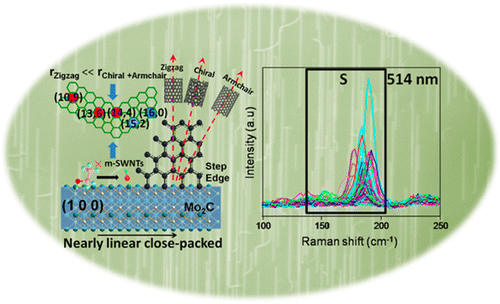当前位置:
X-MOL 学术
›
J. Am. Chem. Soc.
›
论文详情
Our official English website, www.x-mol.net, welcomes your
feedback! (Note: you will need to create a separate account there.)
Diameter-Specific Growth of Semiconducting SWNT Arrays Using Uniform Mo2C Solid Catalyst
Journal of the American Chemical Society ( IF 14.4 ) Pub Date : 2015-07-14 , DOI: 10.1021/jacs.5b05384 Shuchen Zhang 1 , Lianming Tong 1 , Yue Hu 1 , Lixing Kang 1 , Jin Zhang 1
Journal of the American Chemical Society ( IF 14.4 ) Pub Date : 2015-07-14 , DOI: 10.1021/jacs.5b05384 Shuchen Zhang 1 , Lianming Tong 1 , Yue Hu 1 , Lixing Kang 1 , Jin Zhang 1
Affiliation

|
Semiconducting single-walled nanotube (s-SWNT) arrays with specific diameters are urgently demanded in the applications in nanoelectronic devices. Herein, we reported that by using uniform Mo2C solid catalyst, aligned s-SWNT (∼90%) arrays with narrow-diameter distribution (∼85% between 1.0 and 1.3 nm) on quartz substrate can be obtained. Mo2C nanoparticles with monodisperse sizes were prepared by using molybdenum oxide-based giant clusters, (NH4)42[Mo132O372(H3CCOO)30(H2O)72]·10H3CCOONH4·300H2O(Mo132), as the precursor that was carburized by a gas mixture of C2H5OH/H2 during a temperature-programmed reduction. In this approach, the formation of volatile MoO3 was inhibited due to the annealing and reduction at a low temperature. As a result, uniform Mo2C nanoparticles are formed, and their narrow size-dispersion strictly determines the diameter distribution of SWNTs. During the growth process, Mo2C selectively catalyzes the scission of C-O bonds of ethanol molecules, and the resultant absorbed oxygen (Oads) preferentially etches metallic SWNTs (m-SWNTs), leading to the high-yield of s-SWNTs. Raman spectroscopic analysis showed that most of the s-SWNTs can be identified as (14, 4), (13, 6), or (10, 9) tubes. Our findings open up the possibility of the chirality-controlled growth of aligned-SWNTs using uniform carbide nanoparticles as solid catalysts for practical nanoelectronics applications.
中文翻译:

使用均匀 Mo2C 固体催化剂的半导体单壁碳纳米管阵列的直径特定生长
在纳米电子器件的应用中迫切需要具有特定直径的半导体单壁纳米管(s-SWNT)阵列。在此,我们报道了通过使用均匀的 Mo2C 固体催化剂,可以获得在石英基底上具有窄直径分布(约 85% 在 1.0 和 1.3 nm 之间)的对齐 s-SWNT(约 90%)阵列。使用氧化钼基巨簇 (NH4)42[Mo132O372(H3CCOO)30(H2O)72]·10H3CCOONH4·300H2O(Mo132)作为前驱体,通过混合气体渗碳制备具有单分散尺寸的 Mo2C 纳米粒子。程序升温还原过程中的 C2H5OH/H2。在这种方法中,由于在低温下退火和还原,挥发性 MoO3 的形成受到抑制。结果,形成了均匀的 Mo2C 纳米粒子,并且它们狭窄的尺寸分布严格地决定了 SWNT 的直径分布。在生长过程中,Mo2C 选择性地催化乙醇分子 CO 键的断裂,由此产生的吸附氧 (Oads) 优先蚀刻金属 SWNTs (m-SWNTs),从而导致 s-SWNTs 的高产率。拉曼光谱分析表明,大多数 s-SWNTs 可以识别为 (14, 4)、(13, 6) 或 (10, 9) 管。我们的研究结果开辟了使用均匀碳化物纳米粒子作为实际纳米电子应用的固体催化剂对齐单壁碳纳米管手性控制生长的可能性。导致 s-SWNT 的高产率。拉曼光谱分析表明,大多数 s-SWNTs 可以识别为 (14, 4)、(13, 6) 或 (10, 9) 管。我们的研究结果开辟了使用均匀碳化物纳米粒子作为实际纳米电子应用的固体催化剂对齐单壁碳纳米管手性控制生长的可能性。导致 s-SWNT 的高产率。拉曼光谱分析表明,大多数 s-SWNTs 可以识别为 (14, 4)、(13, 6) 或 (10, 9) 管。我们的研究结果开辟了使用均匀碳化物纳米粒子作为实际纳米电子应用的固体催化剂对齐单壁碳纳米管手性控制生长的可能性。
更新日期:2015-07-14
中文翻译:

使用均匀 Mo2C 固体催化剂的半导体单壁碳纳米管阵列的直径特定生长
在纳米电子器件的应用中迫切需要具有特定直径的半导体单壁纳米管(s-SWNT)阵列。在此,我们报道了通过使用均匀的 Mo2C 固体催化剂,可以获得在石英基底上具有窄直径分布(约 85% 在 1.0 和 1.3 nm 之间)的对齐 s-SWNT(约 90%)阵列。使用氧化钼基巨簇 (NH4)42[Mo132O372(H3CCOO)30(H2O)72]·10H3CCOONH4·300H2O(Mo132)作为前驱体,通过混合气体渗碳制备具有单分散尺寸的 Mo2C 纳米粒子。程序升温还原过程中的 C2H5OH/H2。在这种方法中,由于在低温下退火和还原,挥发性 MoO3 的形成受到抑制。结果,形成了均匀的 Mo2C 纳米粒子,并且它们狭窄的尺寸分布严格地决定了 SWNT 的直径分布。在生长过程中,Mo2C 选择性地催化乙醇分子 CO 键的断裂,由此产生的吸附氧 (Oads) 优先蚀刻金属 SWNTs (m-SWNTs),从而导致 s-SWNTs 的高产率。拉曼光谱分析表明,大多数 s-SWNTs 可以识别为 (14, 4)、(13, 6) 或 (10, 9) 管。我们的研究结果开辟了使用均匀碳化物纳米粒子作为实际纳米电子应用的固体催化剂对齐单壁碳纳米管手性控制生长的可能性。导致 s-SWNT 的高产率。拉曼光谱分析表明,大多数 s-SWNTs 可以识别为 (14, 4)、(13, 6) 或 (10, 9) 管。我们的研究结果开辟了使用均匀碳化物纳米粒子作为实际纳米电子应用的固体催化剂对齐单壁碳纳米管手性控制生长的可能性。导致 s-SWNT 的高产率。拉曼光谱分析表明,大多数 s-SWNTs 可以识别为 (14, 4)、(13, 6) 或 (10, 9) 管。我们的研究结果开辟了使用均匀碳化物纳米粒子作为实际纳米电子应用的固体催化剂对齐单壁碳纳米管手性控制生长的可能性。


















































 京公网安备 11010802027423号
京公网安备 11010802027423号